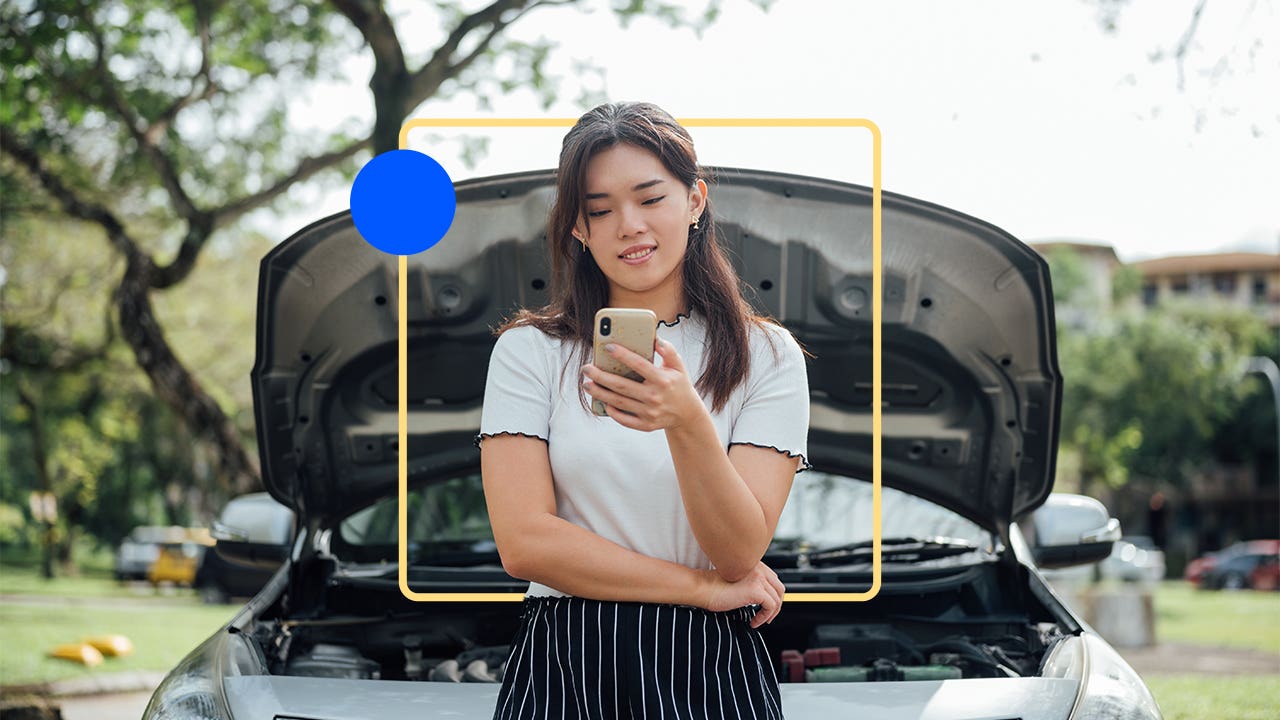The ultimate guide to roadside assistance

The Bankrate promise
At Bankrate, we strive to help you make smarter financial decisions. To help readers understand how insurance affects their finances, we have licensed insurance professionals on staff who have spent a combined 47 years in the auto, home and life insurance industries. While we adhere to strict , this post may contain references to products from our partners. Here's an explanation of . Our content is backed by Coverage.com, LLC, a licensed entity (NPN: 19966249). For more information, please see our .
A flat tire, a dead battery or an engine malfunction can all stop you from getting where you need to go. Luckily, that is exactly what roadside assistance is for. Whether you are unable to change a tire on your own or just looking for added peace of mind, roadside assistance may be a good investment for some drivers. If you have questions about roadside assistance, Bankrate has answers. Below, our insurance editorial team put together the ultimate guide to roadside assistance to help you shop for a policy with confidence.
What is roadside assistance?
Roadside assistance is a service offered to assist drivers, physically and financially, when their vehicle breaks down. This service or membership is typically offered for a fee.
It provides two main benefits:
- Policyholders receive emergency roadside service in the event their vehicle breaks down. Services might include fuel delivery, changing a flat tire or towing to a service center if the issue cannot be immediately resolved.
- Roadside assistance helps mitigate the cost of an unexpected breakdown. Similar to car insurance, roadside assistance policyholders pay a fee (or premium) to the service provider. When a breakdown occurs, the driver will typically not have to pay out of pocket for the emergency services they receive, as long as they are within the policy limit.
To put it in perspective, if your vehicle breaks down and needs to be towed and your roadside assistance plan covers towing, you could save a tidy sum of money. The average cost of a tow is around $109, or between $2.50 and $7 per mile, according to J.D. Power.
What does roadside assistance cover?
When you opt for roadside assistance, the following coverage may be included:
- Towing
- Transportation assistance for a stranded driver and passengers
- Battery jumpstart
- Gas delivery
- Lockout service
- Tire change
- Winching to pull a stuck vehicle out
This is not an exhaustive list. Services vary by company.
What makes roadside assistance different from other coverage?
Roadside assistance is different from other types of coverage that you might get from a car insurance policy or manufacturer’s warranty. Basic car insurance usually covers only the cost of repairing damage from accidents, and emergency response is not an included feature. Warranties will repair or replace malfunctioning parts on your new vehicle, but with the exception of a few rare cases, flat tires and empty gas tanks are not covered.
Note that you can often purchase a roadside assistance plan from your insurance provider or your vehicle’s manufacturer as an add-on to the service you currently have. Just make sure to shop around before you settle on a plan to see if you are getting the best price and service.
Learn more: Compare car insurance rates
Why is roadside assistance important?
Imagine this: you are driving in an unfamiliar location at night when suddenly, you hear the distinct pop and hiss of your tire going flat. Without roadside assistance, you might be stuck on the side of the road trying to change the tire yourself in the dark. But if you do have emergency roadside assistance, help is just a phone call away. A professional will be dispatched to your location to rescue both you and your car.
Everyone should consider roadside assistance, but it is an even more important service to have for the following people:
- Drivers who may be unfamiliar with changing a tire
- Drivers who may find it difficult to step away from their vehicle
- Drivers who have a higher risk of a vehicle breakdown
- Drivers who are in their vehicle often
Where do I get roadside assistance?
There are several places to get roadside assistance:
- Auto insurance companies: One of the simplest ways to get roadside assistance is through your car insurance company. It can be added to your monthly premiums. Some carriers may even include roadside assistance as part of a full coverage car insurance package.
- Member organizations: Organizations such as AAA and Good Sam specialize in roadside assistance. AAA alone has 61 million members. Membership may include travel discounts and other exclusive perks, as well.
- Car manufacturers: If you plan on buying a new or certified pre-owned vehicle, you may receive complimentary roadside assistance for your warranty period. Honda’s roadside assistance lasts three years or 36,000 miles. Kia’s is three years from the date of sale.
- Credit card companies: There are credit cards with roadside assistance, but exactly what you get will vary from card to card. For instance, some cards may only offer roadside dispatch in lieu of roadside assistance. This typically means that you can call a special hotline to have someone sent out to you, but you still may have to shoulder the costs of the exact roadside service.
How to decide which roadside assistance program is the best for you
With so many roadside assistance programs available, you might be torn. Cost is an important factor, but it should not be the only one you consider. Roadside assistance programs offer varying levels of coverage and additional features you may benefit from.
- Look at the towing and call limits: Not all roadside assistance plans are unlimited. Your provider may put a cap on how many times you can use the service or how far your car can be towed before incurring extra charges.
- Look at whether the plan follows the driver or the car: Some roadside assistance plans follow the vehicle, which means that anyone driving that vehicle could use the plan. Other roadside assistance packages follow the driver, which means they could be used for assistance with any vehicle that the driver who has the plan is traveling in.
- Consider other perks: Some roadside assistance plans, like those offered through AAA, may come with a slew of perks and discounts. Although AAA roadside assistance can be more expensive than other plans, some members find that the added benefits make the cost worthwhile.
- Look for trip interruption: If your car suffers a major breakdown far from home, you may need to stay overnight in a hotel. Trip interruption coverage could help cover the cost of lodging and food while you wait for your car to be fixed.
- See if you can extend coverage: Your roadside assistance package may apply even if you are the passenger, or you may be able to extend coverage to family members.
- Check if you have key replacement: Roadside assistance almost always helps if you lock your keys in your car — but what if you misplace them altogether? Key replacement could come in handy in that instance, although you will likely need to pay for the new set.
Many drivers purchase roadside assistance through their car insurance carrier. While this can be convenient, it is important to know that using roadside assistance technically counts as filing a claim — which may increase your cost of car insurance.
What is not included in roadside assistance?
Roadside assistance is not a substitute for serious medical emergencies. If you are involved in an accident, dial 911 immediately. Additionally, your roadside assistance coverage is not the same as a car insurance policy.
Before you commit to a roadside assistance policy, it is important to understand where your benefits end. Some roadside assistance plans will only tow your vehicle up to a certain number of miles. Roadside assistance will also not cover any major repairs. Depending on the car insurance coverage you carry and the cause of the damage, you may end up paying for repairs yourself.
Frequently asked questions
-
-
Bankrate’s extensive analysis of different roadside assistance plans identified AAA, Better World Club and Good Sam as some of the best in the business. However, it is important to remember that the best roadside assistance plan will vary from person to person. Reviewing coverage limitations and prices can help you narrow down which company is best for you.
-
Roadside assistance can be purchased through providers like AAA or AARP, as well as through some auto insurance companies as an add-on to a standard car insurance policy. For instance, Allstate, State Farm and Travelers all offer roadside assistance coverage endorsements.
-
Most roadside assistance plans will typically give you access to coverage 24/7, regardless of the holiday or time of year. If you run out of fuel, pop a tire or something happens that renders your car undriveable, those are all great times to call your roadside assistance hotline. That said, wait times can vary, and if you are in an area with fewer repair shops or towing services, you may have to wait longer for service. It’s also worth noting that roadside assistance is generally not automatically included with your car insurance policy and may require a separate purchase.
-
In most cases, yes, you can use your roadside assistance for vehicles that aren’t yours. That’s because many of the common roadside assistance plans will cover the individual, not the vehicle. That said, it is typically worth checking with your provider to make sure you will have access to roadside assistance when you need it most.
-
Whether or not roadside assistance is worth it will depend on your vehicle and your driving habits. If you drive an older car, you may consider getting roadside assistance; vehicles 10 years old or older are four times more likely to need a tow than newer vehicles. Or, if you tend to take road trips, have a lengthy commute or aren’t particularly car-savvy, roadside assistance could help put you at ease.
-
Many newer vehicles include roadside assistance as a part of the car warranty. You can consult your owner’s manual to see the finer points of your manufacturer’s warranty, like what it covers and how long it lasts. Your car insurance provider may offer roadside assistance, but this is typically something you would need to ask to add to your policy — meaning you’re unlikely to have roadside assistance through your car insurance and be unaware.
-
Related Articles



